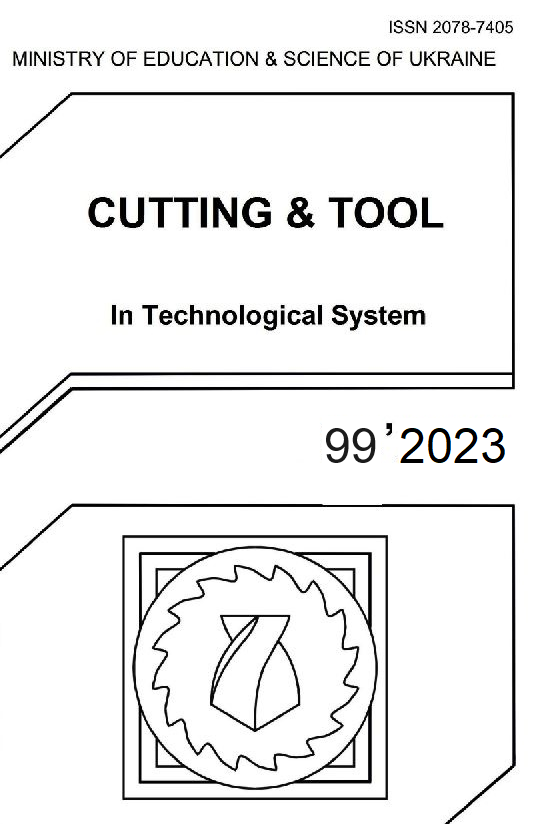ROUGHNESS INVESTIGATION OF SINGLE AND DOUBLE CUTTING MARKS ON FACE MILLED SURFACE
DOI:
https://doi.org/10.20998/2078-7405.2023.99.07Keywords:
face milling, surface roughness, back-cutting of milling tool, secondary material removalAbstract
In machining with defined cutting edge tools, in some rotational tool processes (e.g. face milling) the tool edge may scratch the surface of the workpiece one more time, depending on the cutting conditions, during one revolution of the tool. As a result, the topographies with single or double cutting marks will be different from each other. The deviation, depending on its size, can also affect the functional performance (e.g. friction conditions) of the operating surfaces. In this article, face-milled topographies created with a symmetrical setting and with single or double milling marks are compared according to the magnitude of the roughness and the degree and nature of the inhomogeneity.
References
Mitsyk, A., Fedorovich, V. The nature of the formation of surface micro-roughness in vibration finishing and grinding processing. Cutting & Tools in Technological System. 2022. vol. 97, pp. 103 – 112.
Bali, J. Forgácsolás (in Hungarian). Budapest: Tankönyvkiadó, 1985.
Bajić, D., Majce, I. Optimisation of Parameters of Turning Process. International Scientific Conference on Production Engineering. vol. 47, Zagreb Lumbarda, Hrvatska. 2006. pp. 129 – 136.
Brown, C., Hansen, H., Jiang, X., Blateyron, F., Berglund, J., Senin, N., Bartkowiak, T., Dixon, B., Goic, G., Quinsat, Y., Stemp, W., Thompson, M., Ungar, P., Zahouani, E. Multiscale analyses and characterizations of surface topographies. CIRP Annals - Manufacturing Technology. 2018. vol. 67. pp. 839 – 862.
Kundrak, J., Felhő, C. 3D roughness parameters of surfaces face milled by special tools. Manufacturing Technology. 2016. vol. 16. № 3. pp. 532 – 538.
Hadad, M., Ramezani, M. Modeling and analysis of a novel approach in machining and structuring of flat surfaces using face milling process. International Journal of Machine Tools & Manufacture. vol. 2016. vol. 105. pp. 32 – 44.
Ryu, S., Choi, D., Chu, C. Roughness and texture generation on end milled surfaces. International Journal of Machine Tools and Manufacture. 2006. vol. 46. № 3-4. pp. 404 – 412.
Yin, Y., Du, S., Shao, Y., Wang, K., Xi, L. Sealing analysis of face-milled surfaces based on high definition metrology. Precision Engineering. 2022. vol. 73. pp. 23 – 39.
Thanasuptawee, U., Thakhamwang, C., Siwadamrongpong, S. Evaluation of face milling operation parameters on surface roughness of crankcase housing by two level factorial design with center points. Key Engineering Materials. 2018. vol. 780. pp. 105 – 110.
Franco, P., Estrems, M., Faura, F. A study of back cutting surface finish from tool errors and machine tool deviations during face milling. International Journal of Machine Tools and Manufacture. 2008. vol. 48. № 1. pp. 112 – 123.
Torta, M., Albertelli, P., Monno, M. Surface morphology prediction model for milling operations. The International Journal of Advanced Manufacturing Technology. 2020. vol. 106. pp. 3189 – 3201.
Varga, G., Kundrák, J. Effects of technological parameters on surface characteristics in face milling. Solid State Phenomena. 2017. vol. 261. pp. 285 – 292.
Chuchala, D., Dobrzynski, M., Pimenov, D., Orlowski, K., Krolczyk, G., Giasin, K. Surface roughness evaluation in thin EN AW-6086-T6 alloy plates after face milling process with different strategies. Materials. 2021. vol. 14. № 11. ArtNo. 3036.
Arizmendi, M., Jiménez, A. Modelling and analysis of surface topography generated in face milling operations. International Journal of Mechanical Sciences. 2019. vol. 163. ArtNo. 105061.
Zhenyu, S., Luning, L., Zhanqiang, L. Influence of dynamic effects on surface roughness for face milling process. The International Journal of Advanced Manufacturing Technology. 2015. vol. 80. № 9. pp. 1823 – 1831.
Felhő, C., Kundrák, J. Topography of the machined surface in high performance face milling. Procedia CIRP. 2018. vol. 77. pp. 340 – 343.
Nagy, A., Kundrak, J. Changes in the values of roughness parameters on face-milled steel surface. Cutting & Tools in Technological System. 2020. vol. 92. pp. 85 – 95.
Nagy, A., Kundrak, J. Investigation of surface roughness characteristics of face milling. Cutting & Tools in Technological System. 2019. vol. 90, pp. 62 – 71.
Nagy, A., Kundrak, J. Analysis of inhomogeneity of surfaces milled with symmetrical, down-milling, and up-milling settings. Development in Machining Technology: Scientific – Research Reports vol.10, Krakow, Poland: Cracow University of Technology. 2022. pp. 51 – 62.
Downloads
Published
Issue
Section
License
Copyright Notice
Authors who publish with this Collection agree to the following terms:
1. Authors retain copyright and grant the Collection right of first publication with the work simultaneously licensed under a Creative Commons Attribution License that allows others to share the work with an acknowledgement of the work's authorship and initial publication in this Collection.
2. Authors are able to enter into separate, additional contractual arrangements for the non-exclusive distribution of the Collection's published version of the work (e.g., post it to an institutional repository or publish it in a book), with an acknowledgement of its initial publication in this Collection.
3. Authors are permitted and encouraged to post their work online (e.g., in institutional repositories or on their website) prior to and during the submission process, as it can lead to productive exchanges, as well as earlier and greater citation of published work.

